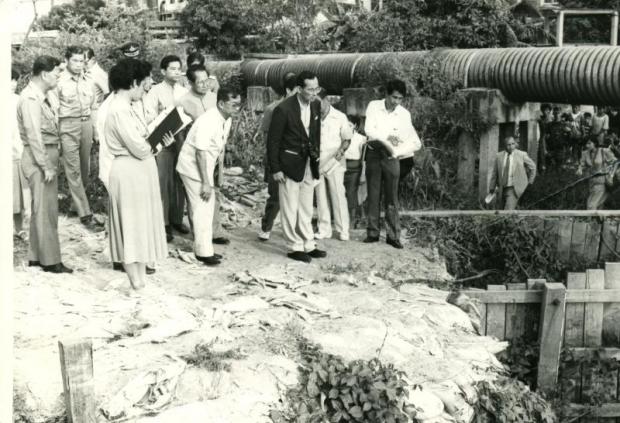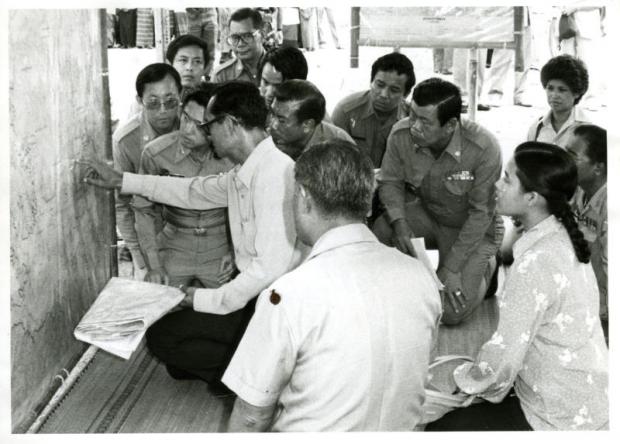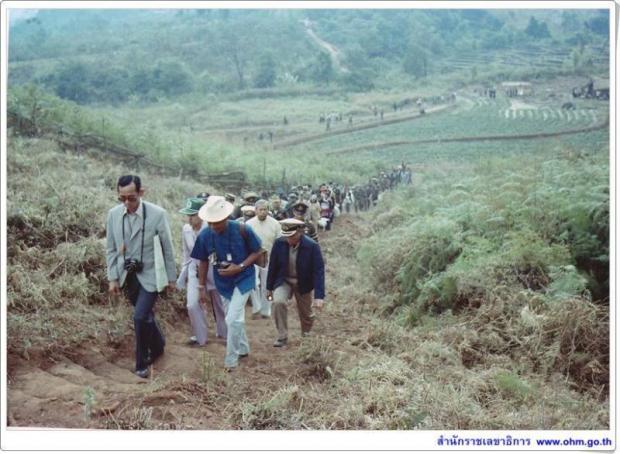
Travelling is known as a way to enrich one's life. But that was not the case for one of the country's most well-travelled people, His Majesty King Bhumibol Adulyadej.
During most of the past seven decades that this country was blessed with the exceptional monarch, Thais have been used to seeing TV news reports on the journeys of the beloved late King to different parts of the country. His destinations, however, were never tourist attractions, lavish restaurants or posh hotels, the kind of places many of us like to show off on social media.
Nai Luang, the intimate and popular term that King Bhumibol was often referred to by his grateful subjects, travelled to places with problems, visiting countless rural villages across Thailand. He braved the scorching sun, heavy rain and difficult terrain to remote and hard-to-reach areas, including battle fields during the armed conflicts with the communists, which took place in the late 60s to the early 80s, to learn first-hand about people's plights from the people themselves.
His camera was not for taking selfies but for reference photos. His maps were not just for finding direction, but for him to get a detailed picture of the area so that he could come up with the most suitable and sustainable solution to the issues in each location, be they the lack of rain, water and soil quality, flood prevention, lack of medical care or other problems. The water we use, the food we eat, from farm products to fish, many things that we have long taken for granted, can be attributed to Nai Luang.

If a village was inaccessible by car and the helicopter was the option, King Bhumibol would have the aircraft land a couple of kilometres from the village, and he would continue on foot. The reason was that he did not want the strong wind from the powerful rotors to cause damage to the poor people's homes.
His Royal life was not one full of glitz, luxury and pampering but one that was down to earth, benevolent and hard working, often spent in harsh conditions.
The old photos on this page give you just a glimpse at the King's 70 years of dedicated hard work. He did it not to win votes; he never needed it. But rather he was determined to keep the promise he publicly made to "reign with righteousness for the benefits and happiness of the people of Siam (Thailand)".
Despite his position and ability to go for vacation anywhere in the world, King Bhumibol, who spent much of his childhood and adolescent years in the West, never travelled away from his Kingdom and his people during the past five decades, except for a brief visit to neighbouring Laos for the opening ceremony of the first Thai-Laos Friendship Bridge in 1994. For him, travelling seemed to be just a part of his tireless effort to improve the quality of life of the people in the Kingdom, regardless of their races or religions, from hill tribes to urbanites.

It wasn't a coincidence that King Bhumibol has been officially regarded as King Bhumibol the Great since 1987, after 41 years on the throne. Unlike in Western countries, in Thailand the title reflects the immense love and gratefulness that Thai people feel towards certain monarchs rather than their successes in wars. King Bhumibol was one of only seven royal rulers in Thai history since the beginning of the Sukhothai Period almost eight centuries ago who were conferred such an honour. Three decades on, until the ailing final years of his life, King Bhumibol the Great has proven that the well-earned title was never tarnished. It was not a secret that even while under medical care at Siriraj Hospital, he also had his patient's room turned into a working station where water levels in the Chao Phraya and other rivers were closely monitored.
For a lot of Thais it's still difficult to accept that Nai Luang is no longer around. Still, his legacy is virtually everywhere. The Royal Projects -- which peacefully and successfully eradicated once sporadic opium cultivation by replacing it with cold climate fruits and vegetables -- are among the numerous places throughout the Kingdom where one and one's family can visit to learn about the inspiring life and works of this Royal role model. The selected places featured in this article are no doubt just a very few examples.






Bhumibol Dam
One of the popular tourist attractions in Tak, Bhumibol Dam is about 60km north of the city. The dam is known as the country’s first arch dam on the Ping River in Sam Ngao district.
Originally called Yanhee Dam in 1951 when the government of former prime minister Field Marshal Plaek Pibulsongkram initiated the project, it was renamed Bhumibol Dam in 1957. It took about 13 years for construction to be completed in 1964 at a cost of 3.5 billion baht. The dam is 154m-high and 468m-long. It can store 13,462 million cubic metres of water, making it the second largest dam in term of water storage capacity after Srinagarind Dam in Kanchanaburi.
The mutipurpose dam is built for irrigation and generating 779MW of electricity annually and has an eight-turbine capacity.
According to Electricity Generating Authority of Thailand (Egat), who manages the dam, in the past 50 years, about 27 million people have visited the dam. Activities include picnics, biking, taking a short boat ride to attractions inside the reservoir including Koh Valentine, Wat Phra Phutthabat Khao Nam, which is a temple atop an isle, where visitors get a great view of the dam.
Also available is the 153km-long cruise from the dam to Doi Tao district in Chiang Mai.
For those who want to stay overnight at the dam, accommodation is provided by Egat or raft houses of private operators.
Call Egat on 055-881211 or visit www.bhumiboldam.egat.com.

Chang-Hua-Mun Project
The latest Royal Initiative Project of His Majesty the King was Chang-Hua-Mun, meaning ‘weighing a yam’, and also The Matter Initiative, in Phetchaburi province. Aimed at teaching people about the approaches to sufficiency agriculture and economy, the project is a learning centre for farmers and an alliance with the public sector and local people.
It was started in 2009 by His Majesty after he had left a yam on an old weighing scale in his Klai Kangwon Palace, Hua Hin district of Prachuap Khiri Khan, and the yam developed into a sapling. After purchasing an infertile 250-rai in Tambon Khao Krapook, Tha Yang district, with his money, His Majesty turned it into an experimental farm, which initially had experimental yam and local economic crop plantations. He also suggested the project focus on the agricultural industry in accordance with market demands.
The project now consists of a dairy farm, economic crops plantations, an organic vegetable farm, organic rice fields, a milk factory, an egg chicken farm, a plant seeds gathering centre, an organic fertiliser unit, an alternative fuel production plant, windmills for electricity generation, knowledge-sharing sessions, a crop cultivation development unit, a soil improvement exhibition, a reservoir and a supermarket for selling farm produce. A wide variety of crops ranging from Thai, Japanese and Penang yam to dragon fruit, Phetchaburi rose apple and rubber trees are grown here.
It is not an overstatement to say that this project is the Father’s Farm and proof of sustainable agriculture, a sufficiency economy, local intellect development and the unity and best efforts of all parties to work together and show their love and loyalty to His Majesty.
Located about 200km from Bangkok, Chang-Hua-Mun Project is open daily from 9am-4pm. Farm tours are provided all day and last about 30 minutes each. Admission fee is 20 baht for adults and 10 baht for children per head, per visit. Call 032-472-701.

Pak Phanang
Located about 36km east of Nakhon Si Thammarat town, the town and district of Pak Phanang, meaning the mouth (pak) of Phanang River, was the rice bowl of the South in the 19th and early 20th centuries before the booming of the shrimp farm business in the late 20th century.
The two businesses hardly co-existed as rice farms need fresh water and can are damaged by salt water from shrimp farms. In addition, people living around Pak Phanang always faced a freshwater shortage during the dry season and floods during the rainy season.
To help solve the problems, His Majesty the King initiated the Pak Phanang River Basin Development Project in 1993. The project brought great benefits to Nakhon Si Thammarat and the neighbouring provinces of Phatthalung and Songkhla.

It prevents saltwater intrusion into freshwater channels, retains reserves of water for year-round consumption, mitigates flooding and reduces conflicts over water between shrimps and rice farmers.
To show gratitude towards His Majesty the King, locals built a palace. It took six years to finish and was handed over to the Royal Household Bureau in October 2007. It consists of 13 buildings constructed in a simple but elegant Southern style with materials like marble and teak. The roofs mimic the shape of a large flower in the hibiscus family called the dixie rosemallow.
The palace is open to the public on weekends from 9am-3pm. Call 075-416-000—3.

Doi Ang Khang
Once covered with opium plantations, Doi Ang Khang, in Fang district of Chiang Mai, today is rich with an impressive agriculture project.
Ang Khang Royal Agricultural Station is the first research station of the Royal Project. It was established in 1969. The station is a demonstration site for planting and researching flowering plants, temperate fruit trees, vegetables and other crops under the patronage of His Majesty King Bhumibol.
His Majesty the King found the valley of Ang Khang has a temperate climate, which is perfect for opium farming. So, he spent his personal money to buy a piece of land and developed the research station here.
Today, Doi Ang Khang is filled up with beautiful farms and garden of temperate-climate flowers. The station’s club serves very impressive dishes of which ingredients are from the project.
Knowledge from the station enables hill tribers to develop their farms. A short drive from the station, close to the Thailand-Myanmar border is Nor Lae Village, where big plantations of strawberry are set among a magnificent view of the scenery.
Besides Kiu Lom Viewpoint, which is a scenic spot to enjoy the sunrise and sunset, there are many nature trails tourists can roam to experience the stunning nature of the mountain, which are dotted with small but beautiful waterfalls and Rhododendron blossoms during the cool season. A number of bird species can be spotted in Ang Khang. The best places are at the Mae Phoe forest station and around Ang Khang Natural Resort.
Doi Ang Khang is 163km north of Chaing Mai city and it takes about three hours by car. Visit www.angkhangstation.com or call 053-969-476 to 78 ext 114.

Doi Inthanon
The country’s highest peak houses a number of beautiful places and development projects initiated by His Majesty King Bhumibol.
In Khun Klang Hmong village, the Doi Inthanon Royal Project was initiated in 2009 under the Royal command of His Majesty King Bhumibol to educate hill tribes on farming and land allocation, to substitute the opium farming which once dominated the area.
The Royal Project is one of the charming attractions in Chiang Mai. Tourists can enjoy temperate-climate plants and flower gardens, highland trout fishery, as well as temperate fruit orchards. The project significantly improves living standards of the local people.
The restaurant in the project serves signature dishes, which showcases produce from the project, such as rainbow trout and salad.
Moreover, tourists can enjoy beautiful scenery of rice terraces and coffee plantations in the Karen village of Ban Mae Klang Luang. A short drive away, the Royal Agricultural Research Stations at Khun Wang and Mae Jon Luang, also feature the successful temperate fruit orchards, including peach and strawberry.
Doi Inthanon is also a national park. This lush mountain has a number of waterfalls where tourists can stop for refreshments while making their ways to the peak. On the way, there are two stupas, which were built in commemoration of His Majesty the King’s 60th birthday and Her Majesty the Queen’s 60th birthday in 1987 and 1992, respectively.
Doi Inthanon is around 110km southwest of Chiang Mai, via Highway 108 and 1009. The Doi Inthanon Royal Project is a kilometre off Highway 1009 at KM 31 intersection. Call Doi Inthanon Royal Project on 053-268-555.

The Thai-Danish Dairy Farm
His Majesty the King is the Father of Thai Dairy Farming. The Thai-Danish Dairy Farm and Training Centre in Saraburi’s Muak Lek district is the country’s first dairy farm and a Royal Initiative Project of His Majesty. It holds much importance for agriculture and agro-tourism in Thailand.
The farm is the brainchild of Their Majesties the King of Thailand and King Frederick IX of Denmark after the King and Queen of Thailand visited Denmark in 1960. According to the Dairy Farming Promotion Organisation of Thailand (DPO), His Majesty had a keen interest in Denmark’s dairy farming because he foresaw that dairy farming would allow Thais to consume nutritious food and become a sustainable occupation for Thai farmers. The government of Denmark later deployed experts to study possibilities of dairy farming in Thailand.
On January 16, 1962, His Majesty the King and the visiting King Frederick IX of Denmark inaugurated the Thai-Danish dairy.
In 1971, the farm and training centre became one of the state enterprises under the Ministry of Agriculture and Cooperatives and became known as the Dairy Farming Promotion Organisation of Thailand (DPO), which works for dairy industry support and development.
Located on land plots covering 2,700 rai on both sides of Mittraphap Road, the centre has a lot for visitors to experience. Activities range from visiting grass fields and forests to milking cows. Visitors will enjoy sightseeing, pure air and a one-hour or 2.5-hour farm tour to learn about dairy farming.
The farm has six major “learning stations” for people to join. Station 1 showcases exhibitions on His Majesty’s sufficiency economy, Thai herbal plants and the demonstration of milk-based fertiliser production. The rest consists of a zoo, video presentation, cow milking training, feeding calves and a horse and cowboy show.
At present, there are more than 400 milk cows in this farm. Most of them are Jersey cows, which yield 15kg of milk per day each. The farm buys 600 tonnes of raw milk out of a total 2,800 tonnes of raw milk that is produced nationwide and accounts for only 48% of the total demand. Dairy farming is indeed a legacy of His Majesty the King who introduced to it to Thailand over five decades ago.
Located about 140km from Bangkok, the farm is open daily with farm tours starting at 9am, 10am, 11am, 1pm, 2pm and 3pm. Fees per head, per visit are 120 baht for adults, 100 baht for university students (group visit), 70 baht for children and young students and free of charge for toddlers. Email agrotour@dpo.go.th or call the centre on 036-344-926.
